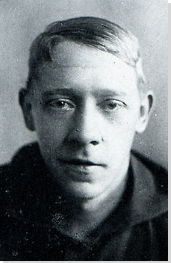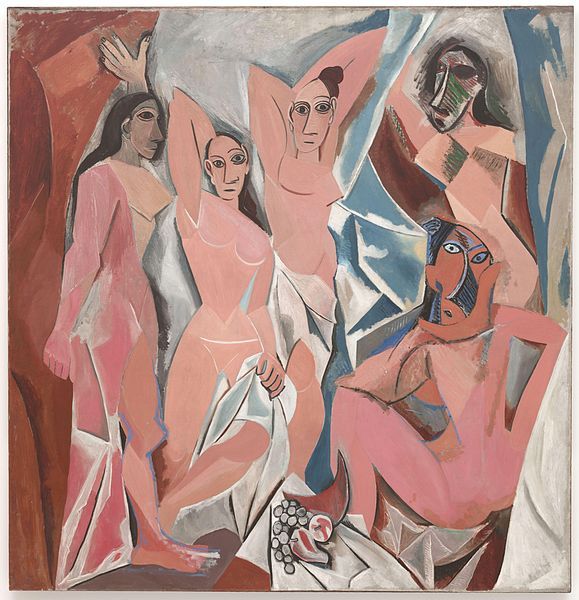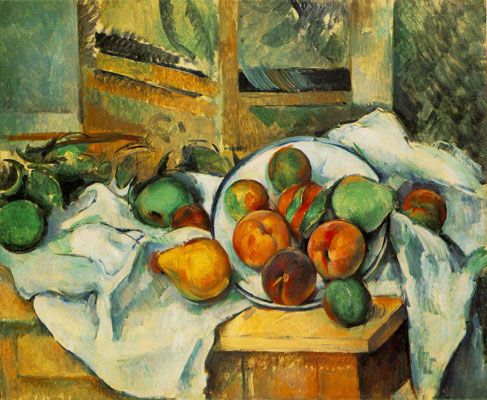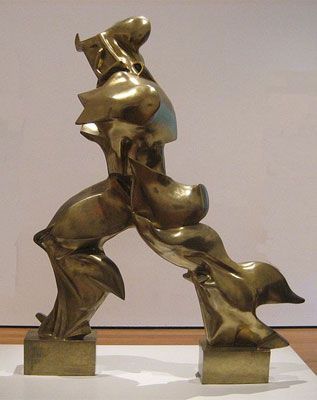Summary of Vladimir Tatlin
Vladimir Tatlin was central to the birth of Russian Constructivism. Often described as a "laboratory Constructivist," he took lessons learned from Pablo Picasso's Cubist reliefs and Russian Futurism, and began creating objects that sometimes seem poised between sculpture and architecture. Initially trained as an icon painter, he soon abandoned the traditionally pictorial concerns of painting and instead concentrated on the possibilities inherent in the materials he used - often metal, glass, and wood. He wanted above all to bend art to modern purposes and, ultimately, to tasks suited to the goals of Russia's Communist revolution. He is remembered most for his Monument to the Third International (1919-20). A design for the Communist International headquarters, it was realized as a model but never built. It crystallized his desire to bring about a synthesis of art and technology, and has remained a touchstone of that utopian goal for generations of artists since. The arc of his career has come to define the spirit of avant-gardism in the 20th century, the attempt to bring art to the service of everyday life.
Accomplishments
- Much of Tatlin's mature work shows a desire to abolish the traditionally representational function of art and put it to new, more practical uses. This accorded with his desire to put art in the service of the Russian Revolution, but also to express the dynamic experience of life in the 20th century. Although this would be more effectively achieved by a later generation of artists, some of whom put art aside to produce advertising and propaganda for the state, Tatlin's work marks an important early stage in the transformation of Russian art, from modernist experiment to practical design.
- Tatlin believed that the materials an artist used should be used in accordance with their capacities and in such a way that explored the uses to which they could be put. In part, this attitude is characteristic of the ethic of "truth to materials," an idea that runs throughout the history of modern sculpture. But Tatlin's approach was distinctively shaped by his desire to bring lessons learned in the artist's studio to the service of the real world. That might explain why his work seems to shift from a preoccupation with the texture and character of materials, to a focus on technology and the machine.
- Tatlin's training as an icon painter may have been significant in suggesting to him how unusual materials might be introduced into painting, but the most important revelation in this respect was his encounter with Picasso's Cubist collages, which he saw on a trip to Paris in 1913. Another echo of his earliest concerns - one that remains in his work throughout his career - is his preoccupation with curves, something that can be traced all the way from his early nudes through the experimental sculpture of his Counter-reliefs up to his architectural Monument to the Third International (1919-20).
Important Art by Vladimir Tatlin
The Sailor: Self-Portrait
In his self-portrait as a sailor, Tatlin displays an early interest in mixed media. He combined different textures of paint, applying it heavily in certain areas and allowing for thin strokes in others. His subject is centered and monumental with respect to the background objects and other figures in the painting, making him the obvious focus and most important feature. These features especially link the work to his prior experience with religious icons. Also in the style of icons, the central figure is flatly rendered and pressed close to the picture plane. The background figures are dark silhouettes, and their considerably smaller size is the only suggestion of depth in the image. The thick black outlines and bright white highlights are also characteristic of his abstract style.
Oil on canvas - The State Russian Museum, St. Petersburg
The Fish Monger
Here, Tatlin fragments the image and separates it into various planes, using heavy outlines to provide definition. The approach suggests the influence of Cubism, though the picture has none of the sharp geometric lines that typically form the fragmented Cubist image. Instead, Tatlin employs curvilinear lines and rounded forms, and predominantly a palette of three colors. Though this is a representational painting, depth and perspective are skewed and the forms of the figures and objects are simplified and flattened.
Oil on canvas - State Tretyakov Gallery, Moscow
The Nude
The technique and color palette employed in this early painting suggest the influence of traditional Russian woodcuts, icon painting, and folk art. Though there are elements of Cubism in The Nude, such as distorted perspective and the breaking down of forms into planes, it is not a Cubist picture. The image is composed of curvilinear planes and lines, and is pressed close to the picture plane in the fashion of an icon (and the use of curvilinear forms would be something that would continue in Tatlin's work up to and beyond his famous Monument to the Third International). The reduced palette and the use of white highlights and black outlines flatly applied are reminiscent of Russian religious icons. Tatlin might have employed such references in an effort to suggest that the picture offers a new icon to replace the old - an icon for modernity that would incite people to action and bring change to society.
Oil on canvas - Tret'yakov Gallery, Moscow
The Bottle
The Bottle is Tatlin's earliest known relief. This work can be viewed as a bridge between his earlier figural paintings and his three-dimensional counter-reliefs, but it was influenced above all by the reliefs the artist saw in Picasso's studio in Paris when he made a trip there in 1913. Indeed, Tatlin later said that Picasso was one of the three painters who influenced him most. In The Bottle, he combines the use of various industrial materials with a painterly analysis of form to produce a work that is not yet completely abstract and has not been liberated from the restrictive, flat, painterly surface. The result is a semi-abstract exploration of materials in the style of a three-dimensional collage, which has not yet fully broken away from the canvas and into the surrounding space. Picasso's collages were clearly a revelation for Tatlin, since they showed that art could be made of all kinds of materials and need not confine itself to oil on canvas.
Wall paper, wood, metal, glass - Photograph: collection of D. Sarabyanov, Moscow
Counter-relief
Counter-relief provides an example of the influence of icons on Tatlin's constructions. Its flat form recalls the heavy metallic embellishments often found in religious paintings. The title Tatlin chose for this series of works suggests an intensification of the object's relationship with the surrounding space (it may also have been inspired by the martial atmosphere of the ongoing World War I). However, this piece does not extend into space in all directions, as would later Counter-reliefs. Instead it draws attention to its surface texture, with metal and leather attachments of various shapes and sizes fixed to the rough, worn wooden frame. This particular selection of materials seems to evoke the elaborate gilded metal frames typically used for religious icons.
Wood, metal, leather - State Tretyakov Gallery, Moscow
Corner Counter-relief
An important element in Tatlin's strategy to dissociate his Counter-reliefs from traditional painting and sculpture was to erect them in the corner of a room. This was a place where a religious icon would be traditionally displayed in a pious Russian household; hence Tatlin suggests that modernity and experiment should be Russia's new gods. The idea is something that may have come from the Technical Manifesto of Futurist Sculpture (1912), a volume by the Italian Futurist Umberto Boccioni, in which he calls on sculptors, "Let's split open our figures and place the environment inside them." Corner Counter-relief evokes the dynamism of modernity, with the various intersecting lines overlapping and moving in different directions to create rhythm and tension. The way that the object spans the corner changes the space of the room and establishes a unique relationship to the surrounding environment. The diagonal wires are evocative of a musical instrument and were perhaps inspired by Tatlin's experience as a musical instrument maker.
Wood, copper, wire - The State Russian Museum, St. Petersburg
Monument to the Third International
Monument to the Third International, also sometimes known simply as Tatlin's Tower, is his most famous work, as well as the most important spur to the formation of the Constructivist movement. The Tower, which was never fully realized, was intended to act as a fully functional conference space and propaganda center for the Communist Third International. Its steel spiral frame was to stand at 1,300 feet, making it the tallest structure in the world at the time. It was to be taller, more functional - and therefore more beautiful by Constructivist standards - than the Eiffel Tower. There were to be three glass units, a cube, cylinder, and cone, which would provide functional space for meetings and would rotate once per year, month, and day, respectively. For Tatlin, steel and glass were the essential materials of modern construction. They symbolized industry, technology, and the machine age, and the constant motion of the geometrically shaped units embodied the dynamism of modernity.
Wood, iron, and glass - Destroyed
Letatlin
Tatlin's last major work, the innovative Letatlin, proves his talent as a visionary. His interest in movement and the forms and harmony of nature prompted him to create a more efficient mode of flight. Having observed the graceful and efficient way that birds travel long distances without expending too much energy, and while remaining seemingly motionless, Tatlin sought to recreate this method by constructing a human powered winged mechanism. For this project, he assembled researchers to study the wings of birds at times even dissecting them to better understand their structure. Through his persistent experiments with materials, Tatlin had gained an understanding of and appreciation for natural structures, and sought to emulate them. Though it was unsuccessful overall, this last construction designed for a more efficient way of living in the new society, remains one of Tatlin's most important projects and solidifies his position as a true innovator and engineer.
Wood, metal, whalebone, silk - Aeronautical and Astronautical Museum, Monino, Russia
Biography of Vladimir Tatlin
Childhood
Vladimir Tatlin was born in 1885 in Moscow. He grew up in Ukraine and attended school in Kharkiv. His father was a railway engineer and his mother was a poet. At a young age, Tatlin left home to work as a merchant sea cadet. He traveled to places such as Turkey, Egypt, Asia Minor, Greece, Italy, and Bulgaria, continuing his adventures at sea intermittently until around 1915.
Early Training
Having copied religious frescoes when he was young, he began formal artistic training as an icon painter in 1902. Many of the stylistic principles employed in icon painting and Russian folk art traditions - the peasant woodcut, or lubok, for instance - had a strong and lasting impact on Tatlin throughout his career.
Tatlin attended the Moscow School of Painting, Sculpture, and Architecture from 1902 to 1904. Afterwards, from 1904 to 1909, he studied at the Penza School of Art under Aleksey Afanas'ev. He belonged to a group of artists whose work addressed the social and political concerns of contemporary Russia, and subsequently became one of Tatlin's greatest artistic influences. He was perhaps inspired by Afanas'ev to devote his efforts to socially relevant art.
After graduating from Penza, Tatlin resumed his studies at the Moscow School of Painting, Sculpture, and Architecture from 1909 to 1910. Around the same time, he also developed close friendships with leading artists of the Russian avant-garde, such as the Vesnin brothers, the Burluk brothers, Natalia Goncharova, and Mikhail Larionov. He became familiar with Larionov's movement, Rayonism - a style of abstract painting derived from the principles of Futurism. The characteristics of this style were the fragmentation of the object through reflected rays and the analysis of the object's relationship to its spatial environment. Tatlin later applied similar principles to his non-utilitarian sculptures. He also began exhibiting in major avant-garde exhibitions in cities such as Odesa, Moscow, and Petrograd.
In 1913, Tatlin traveled to Berlin and Paris. It was during this time that he met another great influence - Pablo Picasso. Tatlin visited Picasso's studio and became acquainted with the Cubist analysis of form through Picasso's three-dimensional mixed-media constructions. The effect of his exposure to these collages and essemblage works is apparent in his mixed-media reliefs, composed of industrial materials such as glass, metal, plaster, and wood, that he began to construct shortly after visiting Picasso's studio.
The earliest known relief from this period in which Picasso's influence is most clearly recognized is The Bottle (1913). This first construction is not yet fully abstract or fully three-dimensional, and, like Picasso's constructions, it is largely painterly in character - in other words, its concerns are no different from painting's traditional, pictorial preoccupation with representing the world. Indeed, Tatlin often referred to these works as "painterly reliefs," but after 1914 he began to create a new type of object and to describe these as "counter-reliefs." The latter are far more concerned with materials and with the space the object occupies; to emphasize this, Tatlin often erected them in the corner of rooms, making them resemble architecture more than painting or traditional sculpture. They were also entirely abstract, allowing the artist to explore the natural potential of the materials used and the new forms they can create through their interaction and juxtaposition.
In these sculptures, the surrounding space is used as another material for construction, interacting with the object and creating dynamism and tension. The geometric corner counter-reliefs, which he started to construct in 1914, are an example of this more developed abstract style. In these corner-spanning works, the flat rectangular frame is discarded and the object is able to fully interact with its spatial environment. By breaking away from the two-dimensional surface and into space, these sculptures embody Tatlin's slogan, "art into life." One might also read them as a fusion of art and engineering, and, in that regard, many critics have pointed to the talents of his parents, one a poet, the other an engineer.
His familiarity with religious icons, as well as his awareness of developments in Western art - from works by Monet, Gauguin, and Cézanne in Moscow collections - is also evident in his early work. In paintings such as The Nude (1913), the influence of icon painting and folk art is clear in the subject's monumentality, spatial configuration, and skewed perspective. What is also significant in some of these paintings is Tatlin's focus on the materiality - or faktura - of the paint. This became central to his later experiments with industrial materials and their natural properties, as well as the ideology of the Constructivist movement as a whole.
Mature Period
Though seeking to establish a new utopian society by breaking with tradition, prior to the October Revolution of 1917, Tatlin and other artists of the Russian avant-garde remained essentially apolitical. Following the revolution, however, Tatlin's artistic focus shifted and his work directly addressed socialist concerns, equating the artist with the proletariat and works of art with mass-produced factory goods. He became devoted to implementing social change through new forms and utilitarian works designed for everyday life.
Project for the Monument to the Third International (1919-20) was the culmination of Tatlin's earlier counter-reliefs, which had employed a non-utilitarian analysis of material and form. Tatlin's Tower, as it came to be known, evolved from earlier experiments with industrial materials into a fully functional construction, aesthetically and functionally symbolizing the ideal communist society of the new modern age.
While this monument was his most famous and last major work of the period, Tatlin remained devoted to the constructivist cause. He worked in the Department of Material Culture in Petrograd, between 1923 and 1925, and focused on creating versatile, multi-purpose clothing designs for the working class. Designs from this period include a multi-seasonal coat and practical working clothes, which provided insulation, freedom of movement, and sufficient air circulation. Tatlin also participated in the constructivist campaign to restructure society by working on designs for more efficient household appliances and furniture designed to better suit contemporary life.
After his project for the monument, Tatlin became primarily interested in teaching. In the 1920s, he held a professorial position at Svomas in Moscow and was the acting head of the Studio of Volume, Material, and Construction at Svomas in Petrograd. In 1923, he also established the Museum of Artistic Culture in Petrograd, which functioned as a laboratory for the experimental study of art. It was at the Museum of Artistic Culture that Tatlin designed, staged, and performed Velimir Khlebnikov's poem Zangezi in 1923. The production featured mechanized geometric planes created by Tatlin to complement Khelbnikov's transrational word constructions. The stage was an important outlet for the avant-garde, as it allowed for their new forms, language, and designs to be seen, heard, and experienced by a large audience.
Late Years and Death
Although he remained active until his death, Tatlin's career as an artist is considered to have ended in 1932 with his last major work, the Letatlin (1929-32), a human-powered flying machine. Tatlin began work on his Letatlin glider in 1929. He conducted extensive research on bird flight and the structure of birds' wings, with the idea that humans would be able to imitate the effortless, efficient, and harmonious flight of birds in nature.
Constructivism and the entire Russian avant-garde died out in the early 1930s when Social Realism became the official style. Tatlin began painting in oils again around this time. However, these later works make little reference to his previous abstract paintings and constructivist sculptures, as they are mostly limited to flower still lifes painted in an expressionistic manner.
The Legacy of Vladimir Tatlin
While the details surrounding Tatlin's life and work are relatively obscure, he remains one of the leading artists of the Russian avant-garde and the creator of the most visionary and influential architectural design to arise from Constructivist ideology. Though his project for The Tower was never fully realized, it is an icon for modernity and has since been an inspiration to artists and architects. His suspended corner counter-reliefs changed the relationship a work of art could have with its surroundings and revolutionized the way in which sculpture could be visualized. Tatlin's constructions, as well as the Constructivist ideology, continually influenced artists throughout the later half of the 20th century by seeking to revolutionize society by introducing new forms of art. Particularly, feminist artists and those involved with the pattern and decoration painting movement of the 1970s and '80s took the Russian Constructivists as direct inspiration. These artists employed craft methods and incorporated everyday objects and materials into their work to expand the boundaries of what could be considered art and to challenge the notions of "high" and "low" forms of art and culture.
Influences and Connections

-
![Pablo Picasso]() Pablo Picasso
Pablo Picasso -
![Paul Cézanne]() Paul Cézanne
Paul Cézanne -
![Umberto Boccioni]() Umberto Boccioni
Umberto Boccioni ![Aleksey Afanas'ev]() Aleksey Afanas'ev
Aleksey Afanas'ev
-
![Primitivism in Art]() Primitivism in Art
Primitivism in Art -
![Futurism]() Futurism
Futurism -
![Russian Futurism]() Russian Futurism
Russian Futurism -
![Cubism]() Cubism
Cubism ![Productivism]() Productivism
Productivism
-
![Alexander Rodchenko]() Alexander Rodchenko
Alexander Rodchenko -
![Dan Flavin]() Dan Flavin
Dan Flavin ![Varvara Stepanova]() Varvara Stepanova
Varvara Stepanova
-
![Lyubov Popova]() Lyubov Popova
Lyubov Popova -
![Mikhail Larionov]() Mikhail Larionov
Mikhail Larionov ![Nikolai Punin]() Nikolai Punin
Nikolai Punin
 Ask The Art Story AI
Ask The Art Story AI































